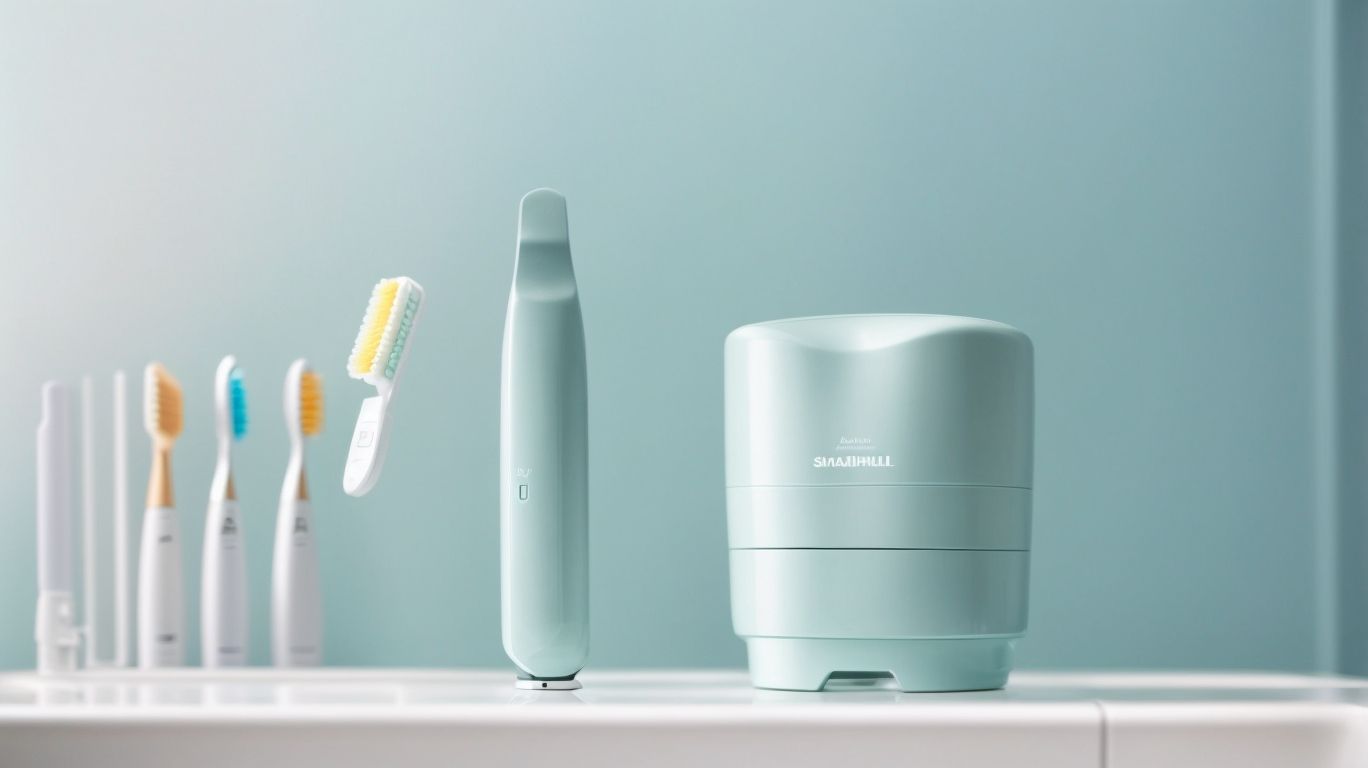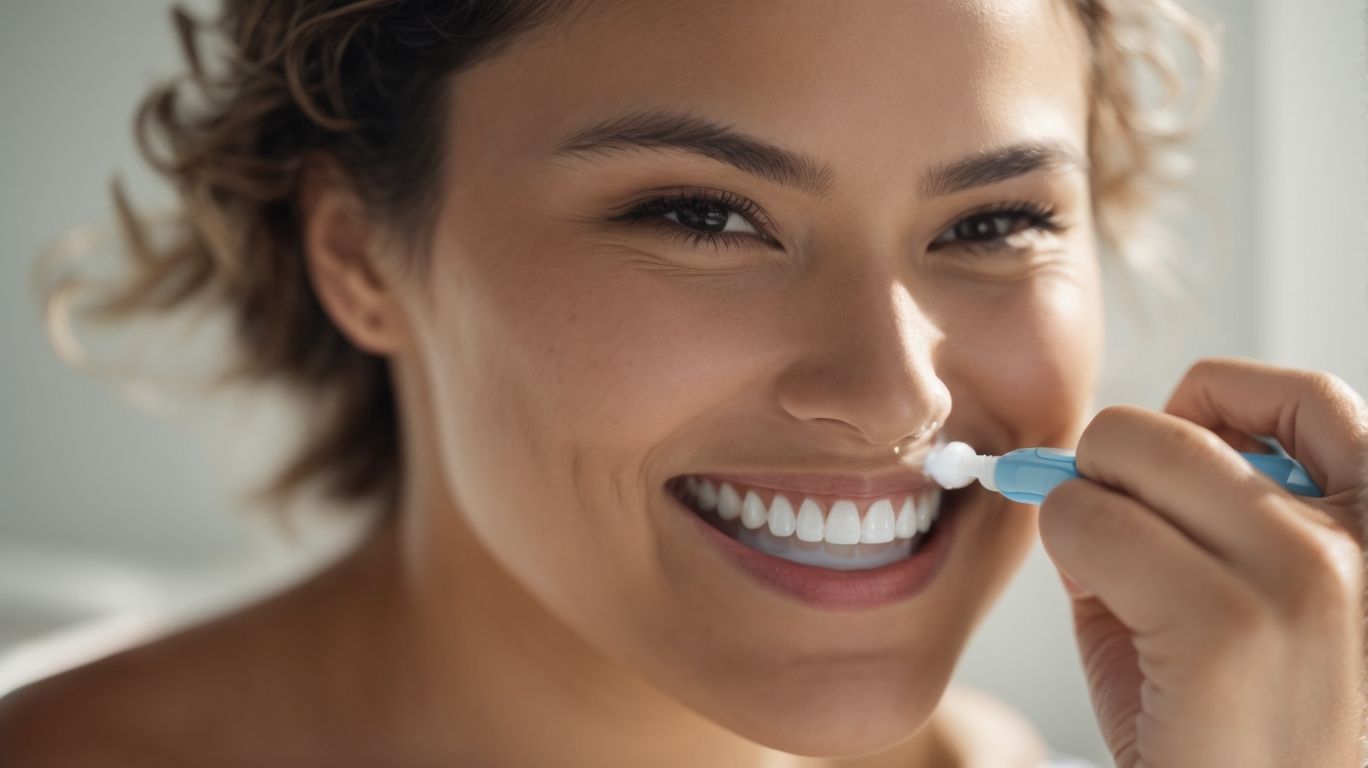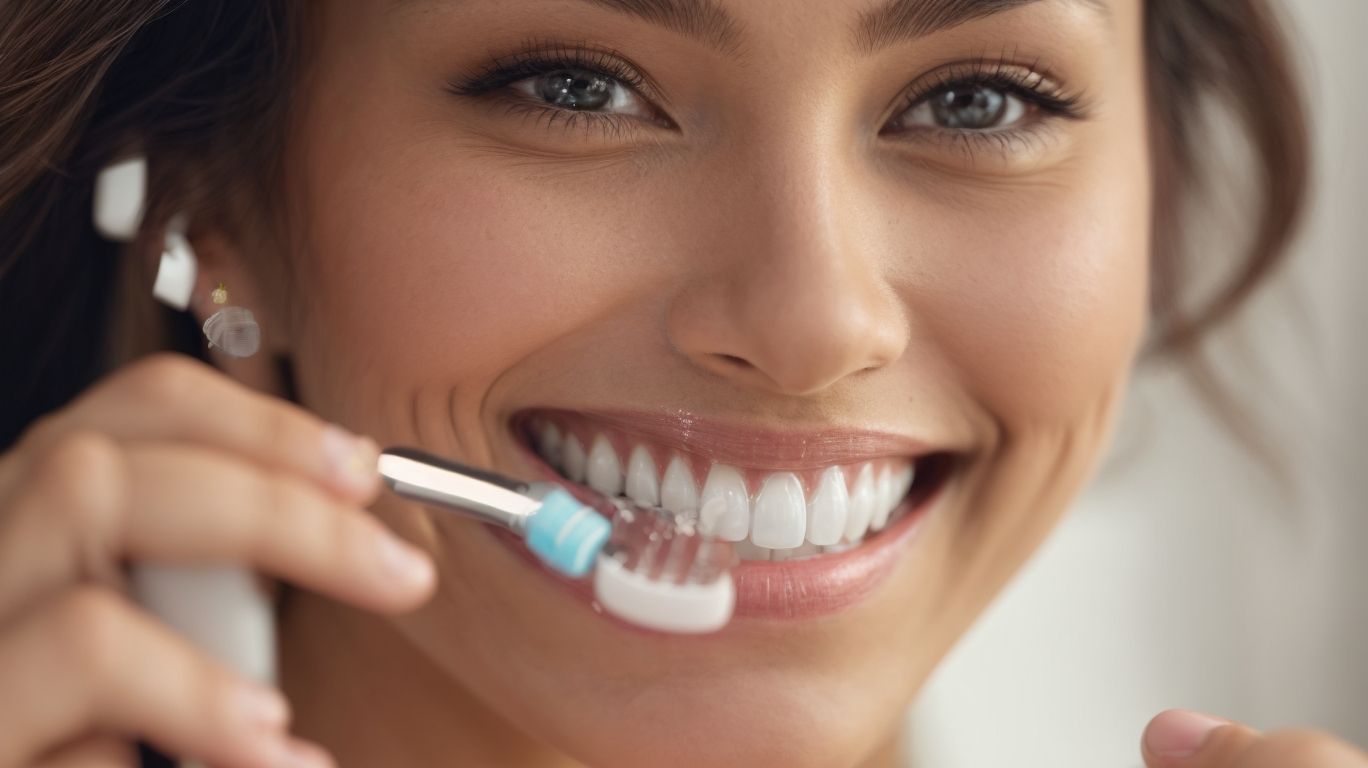.jpg)
Electric toothbrushes have gained popularity for their ability to provide a more effective and efficient teeth-cleaning experience. When used correctly, an electric toothbrush can offer several benefits for oral health. Here are the benefits highlighted by dental expert Dr. Alicia Arbaje:
- More Efficient Plaque Removal: Electric toothbrushes utilize oscillating or rotating brush heads, allowing for better plaque removal compared to manual toothbrushes.
- Improved Gum Health: The oscillating motion of electric toothbrushes not only helps in plaque removal but also stimulates the gums, promoting better gum health.
- Simplicity and Ease of Use: Electric toothbrushes are designed to be user-friendly, making them suitable for individuals with limited dexterity or mobility issues.
- Timers for Optimal Brushing Time: Many electric toothbrushes come with built-in timers that ensure you brush your teeth for the recommended two minutes, promoting thorough cleaning.
To properly use an electric toothbrush, certain steps should be followed to maximize its benefits. These steps suggested by dental professionals include:
- Choosing the Right Brush Head: Selecting a brush head that suits your specific dental needs, such as a soft or sensitive brush head, ensures proper cleaning without causing damage.
- Positioning the Brush Head: Hold the brush head at a 45-degree angle towards the gum line, allowing the bristles to reach both the teeth and the gum area.
- Correct Brushing Technique: Gently move the brush head in circular motions, covering all tooth surfaces, including the front, back, and chewing surfaces.
- Brushing Time: Follow the timer or brush for a full two minutes to adequately clean your teeth and gums.
- Cleaning and Maintaining the Electric Toothbrush: Rinse the brush head thoroughly after each use and replace it every three to four months or sooner if the bristles become worn.
While an electric toothbrush offers several advantages, there are common mistakes to avoid to ensure effective use:
- Applying Excessive Pressure: Let the electric toothbrush do the work and avoid pressing too hard, as it can lead to gum recession and enamel damage.
- Brushing Too Quickly: Take your time while brushing to allow the bristles to adequately clean each tooth surface.
- Neglecting to Brush All Surfaces: Ensure that you brush all tooth surfaces, including the inner and chewing surfaces, to maintain comprehensive oral hygiene.
- Not Replacing the Brush Head Regularly: Over time, brush heads wear out and become less effective in cleaning. Replace the brush head regularly to maintain optimal oral hygiene.
By following the proper techniques and avoiding common mistakes, you can fully benefit from using an electric toothbrush, promoting excellent oral health and hygiene.
Key takeaways:
- Choosing the right brush head: Selecting the appropriate brush head for your specific oral needs is essential for effective cleaning and optimal results.
- Correct brushing technique: Using gentle, circular motions to clean all surfaces of the teeth and gums is the proper way to use an electric toothbrush.
- Regular brush head replacement: It is crucial to replace the brush head every 3-4 months or sooner if the bristles become frayed or worn to maintain optimal cleanliness and effectiveness.
Benefits of Using an Electric Toothbrush

Photo Credits: Feelsgoodtosmile.Com by Albert Adams
Discover why using an electric toothbrush can revolutionize your oral care routine. From more efficient plaque removal to improved gum health, this section unveils the array of benefits an electric toothbrush offers. Uncover the simplicity and ease of use, as well as timers for optimal brushing time, making this modern tool a game-changer in maintaining your dental hygiene. Let’s dive into the science-backed advantages that accompany the use of an electric toothbrush.
More Efficient Plaque Removal
Using an electric toothbrush can lead to more efficient plaque removal, resulting in better oral health. Here are some ways that electric toothbrushes can provide superior plaque removal:
- Movement: Electric toothbrushes have rotating or vibrating bristles that can achieve more efficient plaque removal by reaching difficult-to-clean areas, effectively eliminating plaque.
- Pressure sensors: Some electric toothbrushes are equipped with pressure sensors that alert you if you’re applying too much force, preventing damage to your gums and leading to more efficient plaque removal.
- Timers: Electric toothbrushes often come with built-in timers that ensure you brush for the recommended two minutes, giving you ample time to clean all surfaces and achieve more efficient plaque removal.
- Advanced technology: Certain electric toothbrushes have features like oscillation and pulsation, which further enhance plaque removal and contribute to more efficient plaque removal.
- Ease of use: Electric toothbrushes require minimal effort, making it easier to maintain consistent brushing habits and achieve more efficient plaque removal.
Improved Gum Health
To achieve improved gum health when using an electric toothbrush, there are a few crucial factors to take into account. It is vital to select an electric toothbrush with a gentle brushing mode in order to prevent any potential damage to the gums. Additionally, using the correct brushing technique is important, which involves gently moving the brush along the gumline and in between the teeth. It is also recommended to brush for the suggested duration of two minutes in order to thoroughly clean the gums. Furthermore, replacing the brush head regularly is essential as worn-out bristles can negatively impact the gums. By following these steps, you can effectively contribute to improved gum health while using an electric toothbrush.
Simplicity and Ease of Use
One of the main advantages of using an electric toothbrush is its simplicity and ease of use. With their user-friendly features, electric toothbrushes make oral care a breeze.
- Effortless operation: Electric toothbrushes require minimal effort to use. Just press a button and let the bristles do the work.
- Built-in timers: Many electric toothbrushes come with timers that ensure you brush for the recommended two minutes, making it easier to maintain good oral hygiene.
- Ergonomic design: The ergonomic shape and grip of electric toothbrushes make them comfortable to hold and maneuver, even for individuals with limited dexterity.
- Multiple brushing modes: Some electric toothbrushes offer different modes, such as sensitive or gum care mode, allowing you to customize your brushing experience to suit your specific needs.
Pro-tip: To enhance the simplicity and ease of use, select an electric toothbrush with a replaceable brush head that is easy to find and install.
Timers for Optimal Brushing Time
To ensure optimal brushing time for maintaining proper oral hygiene, electric toothbrushes are equipped with timers. Here are the steps to follow while using the timers on an electric toothbrush to achieve the best results:
- Press the power button to start the toothbrush.
- Observe the timer display on the handle.
- Divide your mouth into 4 quadrants: upper left, upper right, lower left, and lower right.
- Brush each quadrant for 30 seconds, ensuring equal coverage.
- As the timer completes 30 seconds for each quadrant, the toothbrush will either vibrate or pause.
- After completing all quadrants, the timer will indicate a total brushing time of 2 minutes.
By using the timers for optimal brushing time, you can ensure that you brush your teeth effectively and prevent dental issues. Remember to consult your dentist for personalized recommendations, as they can provide you with further guidance on maintaining good oral health.
How to Properly Use an Electric Toothbrush

Photo Credits: Feelsgoodtosmile.Com by Wayne Roberts
Looking to step up your oral hygiene game? In this section, we dive into the nitty-gritty of how to properly use an electric toothbrush. From choosing the perfect brush head to mastering the correct brushing technique, we’ve got you covered. Find out how to position the brush head for optimal effectiveness and learn the importance of brushing time. Plus, we’ll share some handy tips on keeping your electric toothbrush squeaky clean and well-maintained. Get ready to achieve that sparkling smile!
Choosing the Right Brush Head
When it comes to effective oral care with an electric toothbrush, it’s crucial to choose the right brush head. Take into consideration the following factors:
- Bristle Type: Dentists highly recommend soft bristles for a gentle yet thorough cleaning experience.
- Purpose: Different brush heads are designed to meet various oral needs, such as removing plaque, stimulating gums, or catering to sensitive teeth.
- Compatibility: Make sure the brush head is compatible with your specific model of electric toothbrush.
- Durability: Seek brush heads that provide optimal performance by replacing them every three months.
Once Sarah switched to a brush head specifically created for sensitive gums, she immediately noticed a remarkable enhancement in her gum health and overall brushing comfort.
Positioning the Brush Head
Proper positioning of the brush head is crucial for effective cleaning when using an electric toothbrush.
- Hold the brush at a 45-degree angle against the gumline to reach both the teeth and gum.
- Ensure the bristles are touching the teeth and gum, allowing the vibrations to clean effectively.
- Move the brush head in gentle circular motions, covering all surfaces of the teeth.
- Pay extra attention to hard-to-reach areas like the back molars.
- Avoid pressing too hard, as it can damage the gum tissues.
True story: Jane, a diligent brusher, struggled with bleeding gums. After learning about the importance of positioning the brush head, she adjusted her technique and noticed a significant improvement in her gum health.
Correct Brushing Technique
- In order to ensure optimal oral health, it is crucial to follow the correct brushing technique when using an electric toothbrush. Here are some steps to help you brush correctly:
- Hold the brush at a 45-degree angle against the gumline.
- Gently and with short, tooth-wide strokes, move the brush back and forth.
- Brush all surfaces of your teeth, including the outer, inner, and chewing surfaces.
- Pay extra attention to hard-to-reach areas, such as the back molars.
- Divide your mouth into four quadrants and spend 30 seconds on each, brushing for at least two minutes.
By following these steps, you can effectively remove plaque and maintain good oral hygiene. Fun fact: Did you know that the correct brushing technique can help prevent tooth decay and gum disease?
Brushing Time
Using an electric toothbrush effectively requires paying attention to brushing time. Here are some steps to ensure you brush for the appropriate duration:
- Set a timer: Use the built-in timer on your electric toothbrush or set a separate timer to brush for the recommended two minutes.
- Divide your mouth: Split the two minutes evenly between the four quadrants of your mouth (30 seconds each).
- Focus on each tooth: Spend a few seconds on each tooth, ensuring thorough cleaning and plaque removal.
- Don’t rush: Take your time and brush gently but effectively, giving each tooth the attention it needs.
Maintaining proper brushing time helps ensure optimal oral hygiene and prevents oral health issues.
Cleaning and Maintaining the Electric Toothbrush
- To ensure the longevity and effectiveness of your electric toothbrush, proper cleaning and maintenance are essential.
- After each use, make sure to thoroughly rinse the brush head with water to remove any toothpaste residue or debris.
- In order to kill bacteria and germs, consider using a toothbrush sanitizer or soaking the brush head in a mixture of water and hydrogen peroxide.
- To remove any buildup or dirt, regularly clean the handle of the electric toothbrush using a damp cloth or antibacterial wipe.
- Avoid any water from entering the charging port or base of the toothbrush as it can cause damage to the electrical components. Accidentally wet? Simply wipe it dry.
- For optimal cleaning and to prevent bacteria buildup, remember to replace the brush head every 3-4 months or sooner if it becomes frayed or worn out.
By following these simple steps, you can keep your electric toothbrush clean, hygienic, and in good working condition, ensuring a healthier smile.
Common Mistakes to Avoid When Using an Electric Toothbrush

Photo Credits: Feelsgoodtosmile.Com by Jose Young
Avoiding common mistakes when using an electric toothbrush is crucial for maintaining good oral hygiene. In this section, we will uncover the errors that many people make with their electric toothbrushes and how to avoid them. From applying excessive pressure to neglecting certain surfaces, we’ll explore the pitfalls and share tips on achieving optimal brushing technique. By the end, you will have a better understanding of the proper way to use an electric toothbrush and maximize its effectiveness for a healthy smile.
Applying Excessive Pressure
- When using an electric toothbrush, it is important to avoid applying excessive pressure. Applying too much pressure can lead to dental problems and damage the toothbrush itself. Instead, hold the brush lightly and apply gentle pressure.
- To effectively clean your teeth, use short and gentle strokes. Let the brush do the work for you. Avoid brushing aggressively to prevent any potential damage or discomfort.
- When brushing, focus on each tooth individually. Take your time and be thorough. Avoid rushing or using excessive force.
- Pay close attention to your comfort and any signs of discomfort or pain. Adjust the pressure accordingly to ensure a pleasant brushing experience.
- Be particularly cautious when brushing sensitive areas, such as the gums and tooth roots. Avoid applying excessive pressure in these areas to prevent any potential damage or irritation.
Brushing Too Quickly
Brushing too quickly is a common mistake when using an electric toothbrush. Rushing through your brushing routine may lead to incomplete plaque removal and ineffective cleaning. It is important to take the time to properly brush each tooth, spending at least two minutes on your entire mouth. Slow and steady movements, focusing on each tooth individually, will ensure a thorough clean. Remember, brushing too quickly can compromise the overall effectiveness of your oral hygiene routine.
Jane used to rush through her brushing routine, often finishing in less than a minute. She started experiencing more cavities and gum issues. After speaking with her dentist, she realized that brushing too quickly was the cause. Jane started taking her time and noticed a significant improvement in her oral health. Now, she spends the recommended two minutes brushing, giving each tooth the proper attention it deserves.
Neglecting to Brush All Surfaces
Neglecting to brush all surfaces when using an electric toothbrush can compromise oral health. To ensure thorough cleaning, follow these steps:
- Start by placing the brush head on the outer surfaces of your teeth, angling it at a 45-degree angle.
- Gently move the brush head back and forth in small circular motions, covering all tooth surfaces.
- Pay special attention to hard-to-reach areas, such as the back molars and the inner surfaces of the teeth.
- Brush the chewing surfaces using a back-and-forth motion.
- Don’t forget to brush your tongue to remove bacteria and freshen breath.
- Continue brushing for a minimum of two minutes, ensuring all surfaces are cleaned thoroughly.
By neglecting to brush all surfaces, you can compromise your oral health and increase the risk of dental issues. To maintain optimal oral hygiene and prevent problems caused by neglected surfaces, make sure to incorporate the following steps:
- Firstly, start by placing the brush head on the outer surfaces of your teeth, angling it at a 45-degree angle.
- Next, gently move the brush head back and forth in small circular motions, ensuring you cover all tooth surfaces.
- Pay special attention to hard-to-reach areas, including the back molars and the inner surfaces of your teeth.
- Proceed to brush the chewing surfaces using a back-and-forth motion.
- Remember to also brush your tongue to effectively remove bacteria and freshen your breath.
- Lastly, continue brushing for a minimum of two minutes, ensuring you thoroughly clean all surfaces.
By following these steps, you can maintain optimal oral hygiene and prevent dental issues caused by neglected surfaces.
Not Replacing the Brush Head Regularly
Regularly replacing the brush head of an electric toothbrush is crucial for maintaining good oral hygiene. Unfortunately, not replacing the brush head regularly is a common mistake made by many people. It is important to remember that the brush head should be replaced every three to four months or even sooner if the bristles become frayed.
By neglecting to replace the brush head regularly, you might not be effectively removing plaque and bacteria from your teeth and gums. This can ultimately result in oral health problems. To ensure optimal oral hygiene, it is essential to develop a habit of checking the condition of your brush head regularly and replacing it as needed.
Taking this simple step can greatly enhance the effectiveness of your electric toothbrush and contribute to better overall oral health. So make it a priority to regularly replace the brush head of your electric toothbrush and reap the benefits of a healthier smile.
Some Facts About The Proper Way to Use an Electric Toothbrush:
- ✅ Electric toothbrushes can be more effective than manual ones if used correctly.
- ✅ The recommended electric toothbrush is the Oral B 2000.
- ✅ The brushing technique with an electric toothbrush is the same as with a manual toothbrush.
- ✅ Hold the brush at a 45-degree angle with a little pressure and hold on each tooth for 3 to 5 seconds.
- ✅ Start brushing from the outside of the back of the upper teeth on the right and brush all the way around the outside until reaching the back left. Then brush the inside from back left to back right. Move the brush down to the lower teeth and repeat the process.
Frequently Asked Questions
How should I hold an electric toothbrush for proper brushing?
When using an electric toothbrush, hold it at a 45-degree angle with a little pressure towards the gum line. Make sure to hold on each tooth for 3 to 5 seconds.
What is the recommended brushing technique with an electric toothbrush?
The recommended brushing technique with an electric toothbrush is the same as with a manual toothbrush. Start brushing from the outside of the back of the upper teeth on the right and brush all the way around the outside until reaching the back left. Then brush the inside from back left to back right. Move the brush down to the lower teeth and repeat the process.
How long should I brush my teeth with an electric toothbrush?
It is recommended to brush your teeth for a full two minutes using an electric toothbrush. Many electric toothbrushes have a built-in two-minute timer to help you track the time.
Is it necessary to rinse after brushing with an electric toothbrush?
No, there is no need to rinse your mouth after brushing with an electric toothbrush. Simply spit out the toothpaste to maintain the ingredients’ effects in the mouth.
How often should I change the toothbrush head of my electric toothbrush?
It is recommended to change the toothbrush head of your electric toothbrush (or your manual toothbrush) every three months. This ensures optimal cleaning efficiency and prevents the accumulation of bacteria on the brush.
Are electric toothbrushes suitable for individuals with braces?
Yes, electric toothbrushes can be effective for individuals with braces. However, it is important to use a brush head suitable for braces and follow the orthodontist’s instructions for proper cleaning techniques.

A highly skilled and accomplished Doctor of Dentistry, with over 10 years of experience, holding a Doctor of Dental Medicine (DMD) degree from Howard University College of Dentistry, Washington.